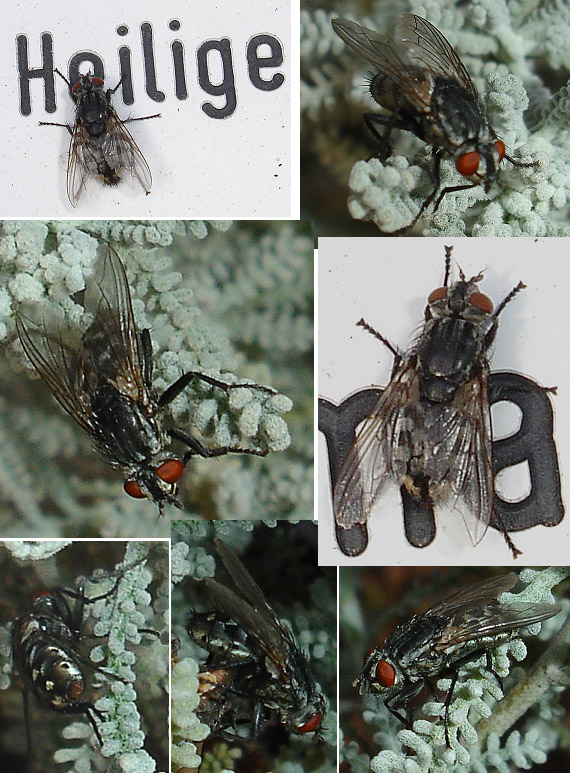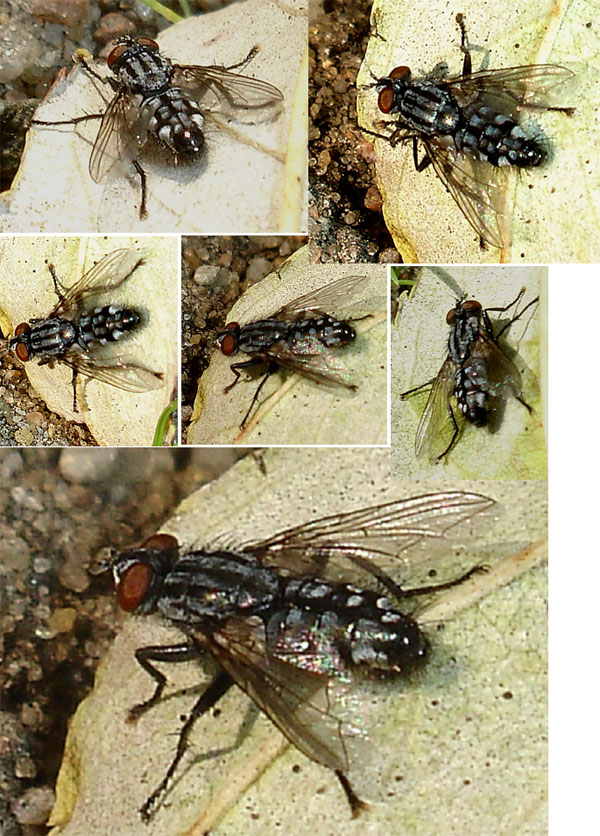Diptera.info :: Identification queries :: Diptera (adults)
|
two Sarcophagas - really...
|
|
| Sundew |
Posted on 20-12-2007 00:31
|
|
Member Location: Berlin and Baden-Württemberg, Germany Posts: 3938 Joined: 28.07.07 |
Hi, I know Sarcophaga is difficult and variable, but in the middle of October I came across two individuals that, by jizz, made me doubt about their belonging to the genus somehow. Here is the first one. It has a brownish abdomen tip (see lowermost left pic) and rather small feet. Sundew attached the following image:  [191.21Kb] Edited by Sundew on 20-12-2007 22:35 |
|
|
|
| Sundew |
Posted on 20-12-2007 00:33
|
|
Member Location: Berlin and Baden-Württemberg, Germany Posts: 3938 Joined: 28.07.07 |
This is the second one. It appears flat and long. Where are the Sarcophaga experts to dissolve my doubts? Thanks, Sundew Sundew attached the following image:  [186.76Kb] |
|
|
|
| Tony Irwin |
Posted on 20-12-2007 20:47
|
|
Member Location: Norwich, England Posts: 7318 Joined: 19.11.04 |
Hi Sundew The first fly is a female, and is one of the species with red genital tergites, but she has been around quite a long while, so the thorax looks black because much of the dusting has worn off (also the wing margin is very tattered). The second fly is a male, with black genitalia and is in better condition. It is difficult to say more about the species from these photos - we need more detail, and remember that many species can be reliably idenitfied only from the genitalia. Sarcophaga is basically a medium to large grey and black stripy/chequered bristly calypterate with red eyes and a bent M vein. But there are other genera that fit this description, and within Sarcophaga, there is a lot of variation - it has been divided into many subgenera, which some dipterists feel should have full generic status. It's a great genus to study, but must be collected to identify the species with certainty. Any species names we put on photos are almost all provisional! And the difference in foot size is one of the features of Sarcophaga - the males have greatly enlarged pulvilli, while the females are more delicate. I believe that the foot pad cells in the pupa have polytene (giant) chromosomes (like those in Drosophila salivary glands). Edited by Tony Irwin on 20-12-2007 20:53 Tony ---------- Tony Irwin |
|
|
|
| Zeegers |
Posted on 20-12-2007 21:42
|
|
Member Location: Soest, NL Posts: 19208 Joined: 21.07.04 |
If have little doubt both specimen are Sarcophaga sl. or just possibly Ravinia (can't tell from these pictures) Theo |
|
|
|
| Sundew |
Posted on 20-12-2007 22:33
|
|
Member Location: Berlin and Baden-Württemberg, Germany Posts: 3938 Joined: 28.07.07 |
Many thanks indeed for all the useful explanations! So the females have little feet and a red backside like a baboon, whereas the big-footed males have a tapering body and sit close to the ground... I am afraid it won't be the last time a Sarcophaga has fooled me; nevertheless, they are very nice flies, aren't they? Cordially, Sundew |
|
|
|
| Tony Irwin |
Posted on 20-12-2007 23:31
|
|
Member Location: Norwich, England Posts: 7318 Joined: 19.11.04 |
Sundew wrote: So the females have little feet and a red backside like a baboon, whereas the big-footed males have a tapering body and sit close to the ground... Only some species have red backsides, and usually (?always) both males and females of those species have red genitalia. As for sitting close to the ground, both males and females do this, but males seem to spend more time sitting around - they haven't got much to do but mate, I suppose.  They sit close to the ground, partly to avoid casting a shadow which might be seen by a predator, but also to take heat from the surface on which they are sitting - a hot fly is a fast fly. They sit close to the ground, partly to avoid casting a shadow which might be seen by a predator, but also to take heat from the surface on which they are sitting - a hot fly is a fast fly. 
Tony ---------- Tony Irwin |
|
|
|
| Jump to Forum: |












